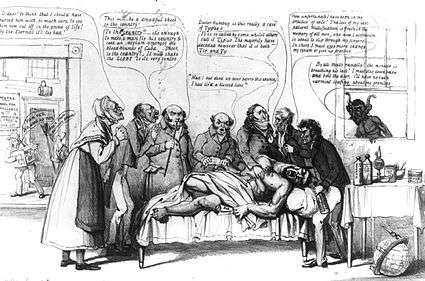Locofocos

The Locofocos (also Loco Focos, Loco-focos) were a faction of the Democratic Party that existed from 1835 until the mid-1840s.
History
The faction was originally named the Equal Rights Party, and was created in New York City as a protest against that city’s regular Democratic organization (“Tammany Hall”). It contained a mixture of anti-Tammany Democrats and labor union veterans of the Working Men's Party, the latter of which had existed from 1828 to 1830.[1] They were vigorous advocates of laissez-faire and opponents of monopoly. Their leading intellectual was editorial writer William Leggett.
The name “Locofoco” derives from “locofoco, a kind of friction match”. It originated when a group of New York Jacksonians used such matches to light candles to continue a political meeting after Tammany men tried to break up the meeting by turning off the gaslights.[2]
The Locofocos were involved in the Flour Riot of 1837.
In the 1840 election, the term “Locofoco” was applied to the entire Democratic Party by its Whig opponents, both because Democratic President Martin Van Buren had incorporated many Locofoco ideas into his economic policy, and because Whigs considered the term to be derogatory.
In general, Locofocos supported Andrew Jackson and Van Buren, and were for free trade, greater circulation of specie, legal protections for labor unions and against paper money, financial speculation, and state banks. Among the prominent members of the faction were William Leggett, William Cullen Bryant, Alexander Ming, Jr., John Commerford, Levi D. Slamm, Abram D. Smith, Henry K. Smith, Isaac S. Smith, Moses Jacques, Gorham Parks, and Walt Whitman (then a newspaper editor).
Ralph Waldo Emerson said of the Locofocos: “The new race is stiff, heady, and rebellious; they are fanatics in freedom; they hate tolls, taxes, turnpikes, banks, hierarchies, governors, yea, almost all laws.”[3]
Origin of name
The name Loco-foco was originally used by John Marck for a self-igniting cigar, which he had patented in April 1834.[4][5] Marck, an immigrant, invented his name from a combination of the Latin prefix "loco", which as part of the word "locomotive" had recently entered general public use, and was usually misinterpreted to mean "self", and a misspelling of the Italian word "fuoco" for "fire".[5] Therefore, Marck's name for his product was originally meant in the sense of "self firing". It appears that Marck's term was quickly genericized to mean any self-igniting match, and it was this usage from which the faction derived its name.
The Whigs quickly seized upon the name, applying an alternate derivation of "Loco Foco", from the combination of the Spanish word "loco", meaning mad or crack brained, and "foco", from "focus". Their meaning then was that the faction and later the entire Democratic party, was the "focus of folly".[6] The use of "Locofoco" as a derogatory name for the Democratic party continued well into the 1850s, even following the dissolution of the Whigs and their reformation as the Republican Party.
In popular culture
The Locofocos are mentioned in Charles Dickens' novel Martin Chuzzlewit when the title character visits the United States.[7]
See also
References
- ↑ Byrdsall, Fitzwilliam (1842). The History of the Loco-Foco or Equal Rights Party. New York: Clement & Packard.
- ↑ Encyclopædia Britannica History & Society: Locofoco Party
- ↑ Kauffman, Bill (20 April 2009). "The Republic Strikes Back". The American Conservative. Retrieved 26 August 2015.
- ↑ Jones, Thomas P, ed. (November 1834). "American Patents". Journal of the Franklin Institute. Pennsylvania. XIV (5): 329.
- 1 2 Bartlett, John Russell (1859). A Dictionary of Americanisms (2nd ed.). Boston: Little, Brown and Company. pp. 252–3.
- ↑ "Loco Foco". Caroll Free Press. Carrollton, Ohio. 22 April 1836. Retrieved 27 August 2015.
- ↑ Dickens, Charles (1844). Martin Chuzzlewit. London: Chapman and Hall. p. 193.
Further reading
- Degler, Carl. "The Locofocos: Urban 'Agrarians'". Journal of Economic History 16 (1956): 322–33. JSTOR 2114593.
- Greenberg, Joshua R. Advocating The Man: Masculinity, Organized Labor, and the Household in New York, 1800–1840 (New York: Columbia University Press, 2008), 190–205.
- Hofstadter, Richard. "William Leggett, Spokesman of Jacksonian Democracy." Political Science Quarterly 58.4 (1943): 581–594. JSTOR 2144949.
- Jenkins, John Stilwell. History of the Political Parties in the State of New-York (Suburn, NY: Alden & Markham, 1846)
- Schlesinger, Arthur M., Jr. The Age of Jackson. (Boston: Little, Brown, 1953 [1945]) For a description of where the Locofocos got their name, see Chapter XV.
- Trimble, William. "The social philosophy of the Loco-Foco democracy". American Journal of Sociology 26.6 (1921): 705–715. JSTOR 2764332.
- White, Lawrence H. "William Leggett: Jacksonian editorialist as classical liberal political economist". History of Political Economy 18.2 (1986): 307–324.
- Wilentz, Sean. The Rise of American Democracy: Jefferson to Lincoln (2005).
External links
-
 "Locofoco". Encyclopedia Americana. 1920.
"Locofoco". Encyclopedia Americana. 1920.